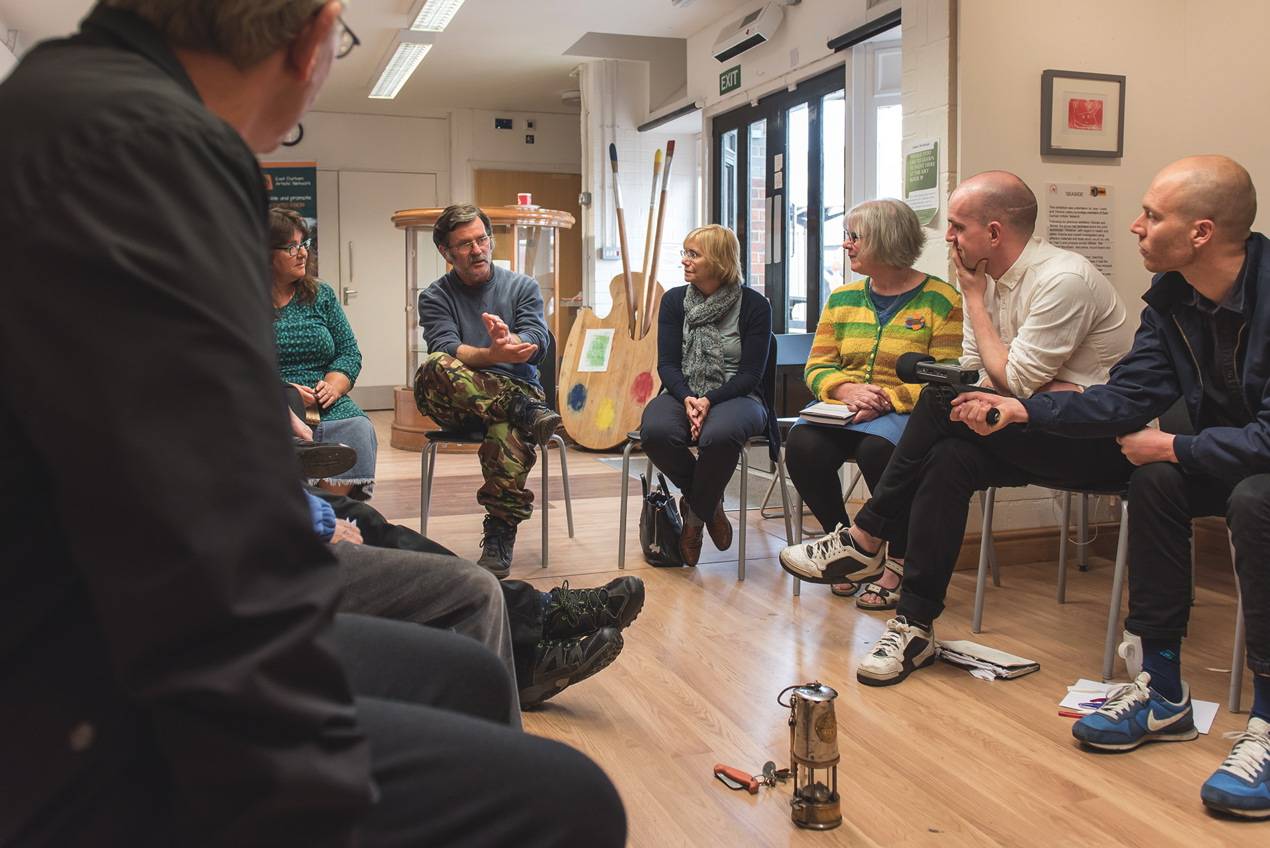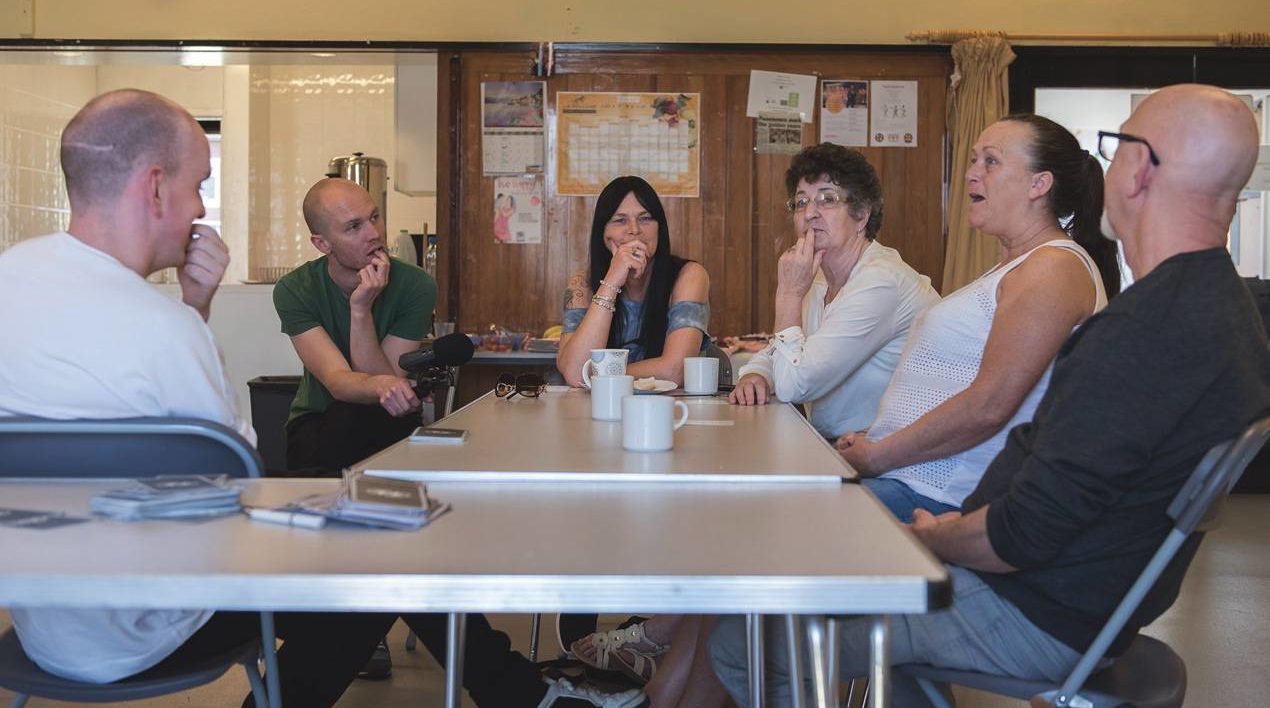Ghosts and
the machine
The closure of pits, deindustrialisation, even living and working by the sea – all can can affect the collective psyche of a community down through generations.
It was a cohort of troubled teenagers who first caught Dr Geoff Bright’s attention.
Back in 2000, he was running an education project for a group of excluded teens from around Shirebrook – on the Derbyshire and Nottinghamshire border – when a curious fact struck him.
“It started to become obvious that these young people all came from coal mining families – but no one was talking about it,” he recalls.
“You get great fondness and love expressed but also a sense of grief and loss and melancholy.”
“This was 15 years after the miners’ strike and these kids had all been born during or just after the strike. They all lived on the streets around the pits and were mostly from families who had been on the frontline during the strike. And here they were, being excluded from school.”
Bright – himself born into a North Derbyshire pit family – noticed other things too. When the young people argued they would use insults normally associated with the strike – calling each other “scabs”, for example. And despite the pits being long closed, the old names lingered on.
He says: “There’s a landscape. A new council park on the site of one former colliery was still known as ‘the pit’. The past was everywhere yet nowhere. It puzzled me.”
Bright, an ex-rail worker who had taken part in the strike and become an active member of the Orgreave Truth and Justice Campaign, later left community education. But he returned to Shirebrook to explore the phenomenon that had so intrigued him for his PhD, conducting ethnographic research in the community.
He experienced a lightbulb moment when he discovered the work of American sociologist Avery Gordon, who argues that communities can be affected in barely visible ways by “social violence” dating back decades – something she calls social haunting. Bright has played with the idea ever since.
Now a research fellow at Manchester Metropolitan University’s Education and Social Research Institute, he has focused his attention largely on working-class communities in the UK’s former coalfields and other areas previously home to heavy industry.
His team’s work explores the notion that invisible anguish can weigh heavily on the collective psyche of an area – distress linked to historic trauma such as mass unemployment or widespread economic hardship caused by deindustrialisation.
Because the pain is passed down to younger generations through stories, emotions and actions, even those who were not alive, or were too young or unconnected to the community at the time of the incident, may adopt the same outlook.
Over recent years, Bright and his colleagues have worked on three Arts and Humanities Research Council-funded projects in South Yorkshire, Lancashire, the North East and Staffordshire. They collaborate with local residents to try to unleash the ghosts of the past and explore future possibilities for their areas.
In a relatively unusual move for academics, they have created formal partnerships with two outside organisations to undertake the work – educational charity the Cooperative College, and Unite Community, a branch of the trade union.
The resulting multi-disciplinary team has come up with creative ways of working with local people – developing a form of workshop they call a ghost lab, led by poets and community researchers. Participants are invited to bring and discuss objects that are meaningful to them, and facilitators use a set of specially designed tarot cards featuring an ambiguous range of words, logos and images, intended to prompt and open up discussions.
Creative practitioners including actors, musicians, a comic artist and a community broadcaster have also taken part in different parts of the project.
Retired teacher Mark James – who taught in several pit village schools during his working life – became a co-investigator through Unite Community in Sheffield. He helped run ghost labs in the East Durham coalfield, as well as at Durham Miners Gala and the Great Yorkshire Show.
He says: “There’s great complexity and nuance in this project. You often know the ghost is there but when you turn around it’s gone. We try to get beneath the surface through anecdotes – that is how you get deeper information. My feeling is the haunting is often expressed in different ways. You get great fondness and love expressed but also a sense of grief and loss and melancholy. All these emotions are wrapped together in very subtle ways.
“The issues in communities like these are very complex and anyone who says they can wave a magic wand and make this better is wrong. Of course they need investment but I think there’s more to fixing the legacy of the strike, deindustrialisation and globalisation. These places have been robbed of their richness and esteem.”
The Cooperative College has worked in Rochdale, running workshops at the Pioneers Museum, with Pakistani women through the Workers Education Authority and with young people from Rochdale and District Mind. It also worked in Stoke with a group of asylum seekers and refugees from the Jubilee Project.
Dr Amanda Benson, from the organisation, says one aim was to take the pulse of these areas in the wake of the Brexit referendum – since Rochdale voted strongly in favour of leave, despite being home to a diverse population.
She says: “People in Rochdale talked a lot about the place being on its knees and enduring scandals over recent years – grooming, for example – and about wanting to make the town better. The young people talked about how it’s hard to be from Rochdale because people laugh at them. The Pakistani women talked a lot about missing Pakistan and how it’s hard to be split between different places.
“The asylum seekers and refugees talked about how they just want it to be safe enough to return home. One woman had moved from Afghanistan to Iraq after the invasion, and then the same thing happened there. She then moved to Syria, but was displaced again. All she wanted was to see her grandchildren grow up but her family was now spread across different countries. These people had endured real hardships but had created a sort of family in the groups they were attending.”
Sheffield-based community broadcaster Max Munday, who used audio captured at ghost labs to produce two radio documentaries on the project, says his own ideas about events such as the miners’ strike had been challenged.
“The narratives in my head have become more sophisticated,” he says. “I’ve learned that simplistic narratives are not very helpful. The experiences of ordinary people are not nice and neat – yet complexity is often absent from left [wing] narratives.
“We met feminists in County Durham who talked about the patriarchal structures which existed in the pit villages. And were scabs anyone who didn’t strike for the full 12 months? The experiences people had of industry weren’t always positive and they don’t necessarily want to be defined by the industrial action.
“I think the social haunting project has created space where people could challenge some of the rose-tinted narratives. Yes, it was great that people had jobs but workers also got killed in freak accidents and developed lung diseases.”
For Bright, the aim is to start a conversation about how the harm caused by these unresolved histories could be repaired. Despite millions of pounds being invested into former pit areas since the end of coal, they still struggle – so something else is required.
In Shirebrook, Sports Direct built a vast warehouse complex on the site of the former pit a decade ago. A place where unionised local workers used to earn a decent wage soon became synonymous with exploitation. Its largely imported Eastern European workforce was found to be paid below the minimum wage, with pay docked for being as little as a minute late, and subjected to searches at the end of every shift. The social haunting work is by necessity political.
Bright says: “The narrative from the government [in the early 1980s] was that coal industry was reaching the end but we weren’t being told of the political decision that it should instead be imported through globalised neoliberal routes. This meant moving away from trade unions and using liberalised workers elsewhere who are in precarious situations.
“I would argue that ending the coal industry was about creating a political opportunity for further exploitation by the likes of Sports Direct. The whole process has been traumatic for a lot of local people, as well as for the migrant workers who were brought there and people have to question this.
“However, if we focus only on the trauma we would close off any political questions which contribute to its development.
“In our ghost labs, people talk a lot about everyday solidarities and about what it means to belong, to be together, to have a decent life. The point of this research is to start that conversation – we are not proposing solutions. But we find people from these communities want to talk about this and do so with a level of reflection that most research misses.”
Photos: Carl Joyce

When mining was raised as an issue for people in Seaham, County Durham, Jean Spence was not surprised. But the importance of the sea to the psyche of her small coastal town was unexpected.
“That was an insight for me. The concept of social haunting is a bit slippery – it’s beyond personal history and is more about what resonates with other people,” she says.
“The sea is so integral to this place that it was easy to miss. But people carry it with them. What they said about it often related to some sort of trauma – for example, the people who had died there.”
Spence’s art group, East Durham Artists Network, hosted a ghost lab session in which participants were asked to bring along objects that were meaningful to them.
Several men brought items connected to their working lives as coal miners – a knife, a pit token and so on. Women’s objects often related to family history and the division of labour along gender lines. One brought a fossil her father had found down the pit.
“She had become estranged from him so the object was quite ambiguous and imbued with emotions linked to their relationship,” recalls Spence.
Her group went on to set up a mining art group and organise an exhibition about the legacy of mining. Audience members who saw the work then shared their own personal histories, including relatives who had died in the Durham Colliery and suffered ill health caused by years down the mines.

Leave a reply
Your email address will not be published.